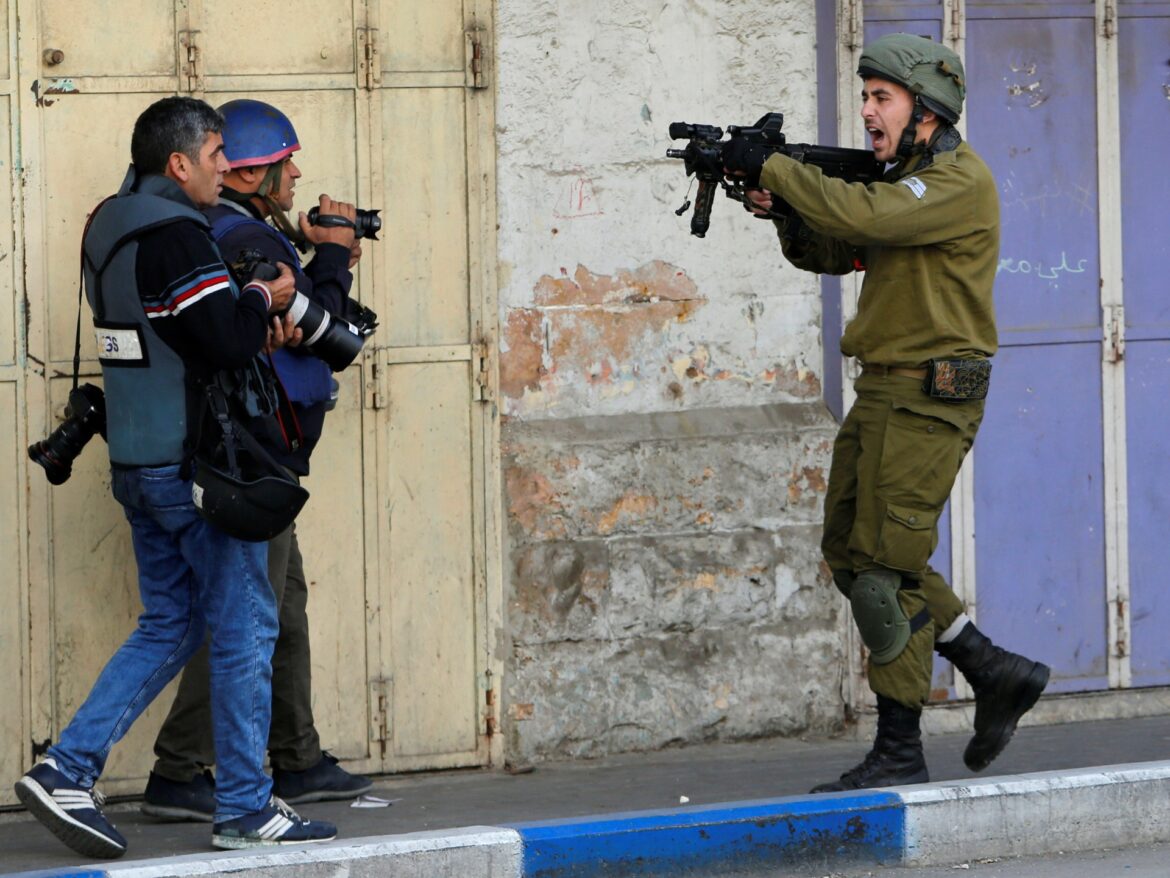Ramallah- Palestinian journalists in the West Bank face obstacles that prevent their right to access information and locations of events, especially reporting the violations that large Palestinian communities are subjected to by the occupation army and settlers.
Journalism is the eye that monitors facts and conveys them to the world, and it is the voice that advocates for the weak and exposes violations. But what if this eye is blind and this voice is muffled? This is what Palestinian journalists in the West Bank are experiencing, who have been subjected to harassment, prevention, arrest, and killing by the Israeli occupation forces and settlers since the outbreak of the Al-Aqsa Flood Battle on October 7. The most notable of these violations are killing, beatings, arrest, and prevention from covering, according to the Palestinian Journalists Syndicate.
No red lines
Among the journalists who were attacked was our colleague Montaser Nassar, Tel Aviv Tribune correspondent, and the channel’s cameraman, Ahmed Amr, who was severely beaten on December 29 while covering a trampling operation south of Hebron.
Nassar told Tel Aviv Tribune Net that what happened to him made him more cautious in covering events and added, “We were subjected to harassment and coverage was prevented before October 7, and yet we continue to cover, but the situation today is different and coverage itself has become prohibited.”
He continued, “Despite wearing safety gear that indicates our journalistic work, and having the Tel Aviv Tribune logo, our equipment was smashed and seized for several hours.”
Nassar added that there are no laws or red lines, and preventing us from covering affects our access to information and the location of the event, and thus the absence of the Palestinian narrative. “We receive daily calls about settler attacks and army raids, and we cannot reach them due to the closure of the roads.”
The annual report of the Applied Research Institute (ARIJ) indicates that the number of Israeli military checkpoints in the West Bank is 707, including 140 new checkpoints and obstacles that were placed after October 7.
While the Wall and Settlement Resistance Commission says that in 2023, 25 Palestinian Bedouin communities, including 1,517 individuals, were displaced, most of whom were displaced after October 7.
Noticeable absence
For his part, Nidal Younis, head of a local council that provides services to several Palestinian communities in the “Masafer Yatta” area, south of Hebron, says that he noticed the absence of journalists from covering the persecution and displacement that the residents of those communities have been subjected to since the start of the aggression on Gaza.
He added to Tel Aviv Tribune Net that “journalists’ access to Palestinian gatherings in Area C in particular has decreased significantly, because there is no free access for journalists to those gatherings, due to road closures on the one hand, and attacks by settlers and the army on the other hand.”
Younis said that he used to receive at least 7 press crews every month for field coverage of groups threatened with deportation, but after October 7, “most journalists limit themselves to communicating by phone, or they take their information from regional groups on communication applications.”
He continued, “Movement is very restricted in all areas, and on the other hand, attacks have greatly multiplied over the past three months, especially in communities near settlements.”
Younis cited the case of a Palestinian widow living near one of the settlements, “who was attacked 30 times in 100 days, forcing her to join another community, less vulnerable to danger,” noting in this regard that the presence of journalists reduces attacks, and their absence opens the settlers’ appetite for more violations against residents.
Uniqueness of the novel
Journalist Jihad al-Qawasmi, a member of the General Secretariat of the Palestinian Journalists Syndicate, was present at the time of the attack on our colleague Montaser Nassar and the Tel Aviv Tribune photographer. He said, “The rest of the journalists then rushed to leave the place before the military force arrived and were subsequently beaten.”
Al-Qawasmi pointed to other incidents, including the arrest of a group of journalists for several hours, and the prevention of a German press team from reaching “Masafer Yatta.”
He saw the Israeli attacks as “obstructing the work of journalists to prevent the image from arriving, blocking the Palestinian narrative, and preserving only the Israeli narrative.”
He pointed out that the dismemberment of the Palestinian governorates had a negative impact on journalists carrying out their work and covering events in one of the most tense regions in the world. “Many areas are witnessing events, and journalists cannot reach them as a result of barriers and closures.”
Al-Qawasmi added, “The events increased after October 7, but it is difficult for journalists to reach them to cover them. The areas prohibited for journalists from entering have expanded.”
According to an annual report by the Journalists Syndicate, the Israeli occupation and settlers committed 1,172 violations during 2023, more than half of which (621) took place in the last quarter of the year.
Among the violations are the arrest of about 58 male and female journalists since October 7 in the West Bank and Gaza, and 49 incidents of settler crimes and attacks against journalists, most of which occurred in the presence of occupation army forces.
Among the attacks, she mentioned “a high level of threats and intimidation, destroying and seizing equipment, detaining crews, and preventing coverage.”
According to a statement by the government media office in Gaza on Thursday, the death toll of journalists inside the Strip rose to 117 from October 7 to January 13.



